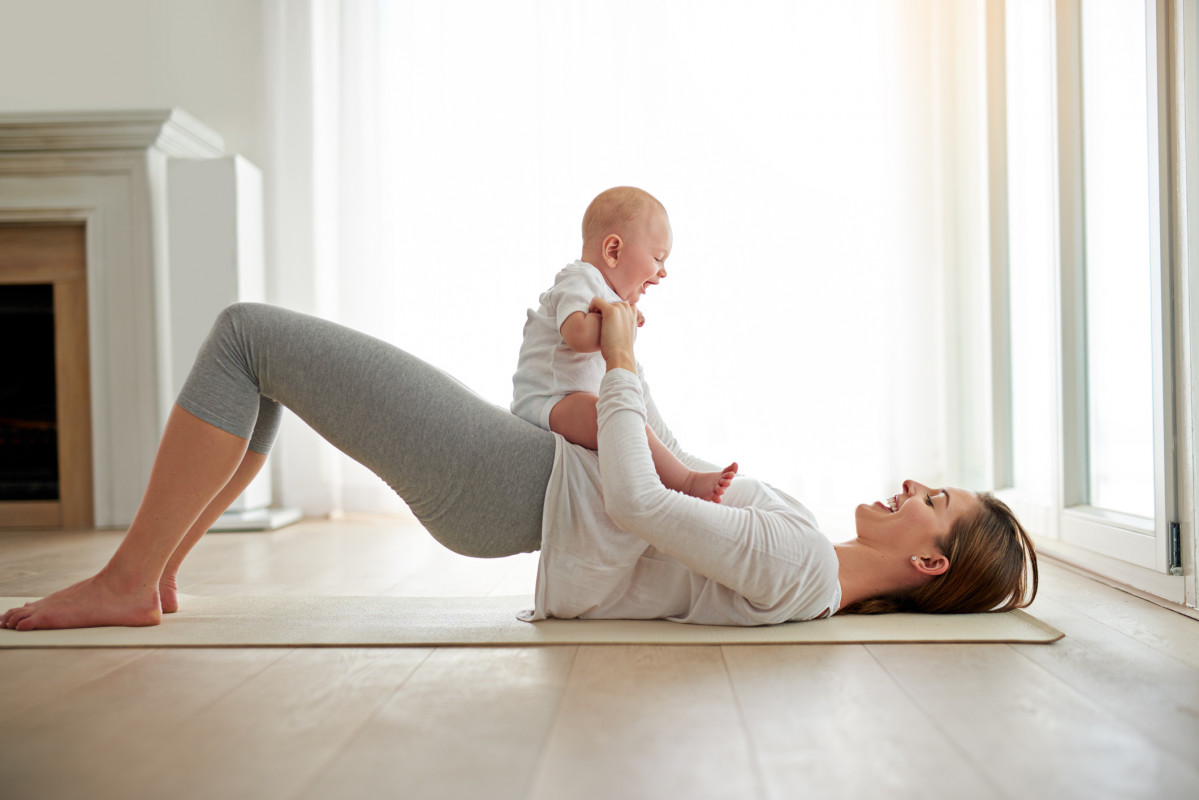
During your pregnancy, many changes have occurred in your body to enable you to maintain the pregnancy and deliver your baby. These changes include stretching of your abdominal muscles, stretching and potential weakening of your pelvic floor muscles and hormonal changes to soften your pelvis and its ligaments. After the delivery of your baby whether that be vaginally or by cesarean section, the abdominal and pelvic floor muscle tone are reduced (especially in vaginal deliveries) and the hormonal changes can continue to impact the soft tissue structures after birth. These factors can commonly combine to cause low back pain, pelvic pain, leakage of urine (incontinence) and pelvic/ vaginal heaviness or bulge (pelvic organ prolapse).
Why exercise after having a baby?
Exercise has a wide range of health benefits for women following childbirth. These include:
- Strengthening and toning
- Abdominal muscles
- Increasing energy levels
- Promoting better sleep
- Stress relief
- Can be helpful in preventing postpartum depression
However, the type and intensity of exercise is very important to prevent the occurrence of pain, incontinence and pelvic organ prolapse in the early days after having your baby and to reduce the risk of developing these issues in the future.
How can women’s health physiotherapists help?
Women’s health physiotherapists (also called continence or pelvic physiotherapist) are specifically trained to be able to assess and treat abdominal muscle separation, pelvic floor muscle strength and endurance as well as bladder or bowel dysfunction.
In the post-natal period your physiotherapist can assist you in assessing your baseline level of abdominal and pelvic floor muscle function and guide you through your recovery to make your return to exercise as safe and effective as possible.
Importance of pelvic floor muscle exercises
The pelvic floor is a group of muscles and other tissue that form an elastic hammock between the tailbone at the back and the pubic bone at the front of the pelvis. The pelvic floor muscles support pelvic organs (bladder, uterus and bowel), pelvic joints and have a role in bladder and bowel control as well as sexual function.
Research has shown that up to 50% of women incorrectly perform a pelvic floor muscle contraction if only given a verbal instruction. This shows the importance of a baseline assessment in the post-natal period to ensure these muscles are activating correctly.
Basic pelvic floor muscle activation technique
- Squeeze and lift (draw in) the muscles around the vagina as if trying to stop the passing of urine and around your back passage as if trying to stop the passing of wind. It is important to fully relax these muscles at the end of each contraction.
- Ensure that you continue to breathe normally and do not hold your breath. Relax your buttock and thigh muscles.
- It is easier to begin pelvic floor exercises in lying or sitting positions and to progress to standing positions.
- If you have difficulty contracting these muscles or are unsure if you have the correct technique, your women’s health physiotherapist can assess and tailor a specific program for you
Below is a general guideline for a graded return to exercise post pregnancy.
If you have had a complicated pregnancy or delivery of your baby, please seek professional advice before returning to exercise.
0-6 weeks
- Gradual return to low to moderate intensity cardiovascular exercise such as walking, stationary upright or recumbent cycling or cross trainer. This could begin with 10 mins per day and gradually increase to 30-60 mins per day if comfortable
- Postnatal abdominal muscle activation (core stability) exercises
- Pelvic floor muscle exercises
6-12 weeks
- It is recommended that you wait for your 6 week postnatal check with your doctor before you commence a group exercise program or returning gym based exercise
- Moderate intensity cardiovascular exercise such as walking, swimming (once bleeding has ceased), cycling, cross trainer for 30-60mins per day.
- Progression of core stability and pelvic floor muscle exercises by seeking advice from your local women’s health physiotherapist or trained professional
- Postnatal exercise classes such as Pilates or Yoga
- Light resistance exercises using no larger than 2kg weights or light Theraband for resistance work
12-16 weeks and beyond
- Consider visiting a women’s health physiotherapist for a postnatal assessment of your abdominal and pelvic floor muscles prior to returning to high-impact exercises or sport
- Recommence higher intensity cardiovascular exercise such as running, jumping and graded heavy resistance exercises with weights or Theraband. It is important to monitor symptoms such as back or pelvic pain, incontinence and/or pelvic organ prolapse symptoms during or after exercise
How to prepare for exercise
- Wear comfortable clothing and a well fitted and supportive bra.
- Have a bottle of water and take frequent sips to keep hydrated.
- If breastfeeding, feed your baby or express your milk before your workout to avoid any discomfort from engorged breasts.
- Include a warm up and cool down into your exercise routine to help get your muscles ready to exercise and prevent muscle soreness.
- Remember, listen to your body and be aware of any warning signs of discomfort or pain.
At Westmead Private Physiotherapy
We have specialist women’s health physiotherapists available to assess, guide and assist you from the journey of pregnancy to motherhood and beyond.
Our physiotherapy team teach our Mum’s and Bub’s Pilates classes at Westmead Private Hospital on Wednesday and Friday mornings. Please contact the Westmead Private Physiotherapy for more information on 96331035.
Lara Pogorelsky is a Women’s Health physiotherapist with a special interest in managing ante-natal and post natal pelvic pain and managing incontinence and prolapse. Lara works out of our Westmead rooms and runs our Friday morning Mum’s and Bub’s Pilates classes.
References:
- Pelvic floor first (www.pelvicfloorfirst.org.au)
- American college of Obstetricians and Gynecologists (ACOG) 2015








